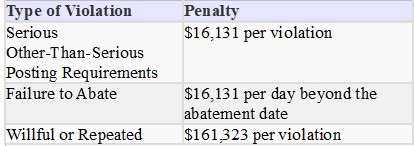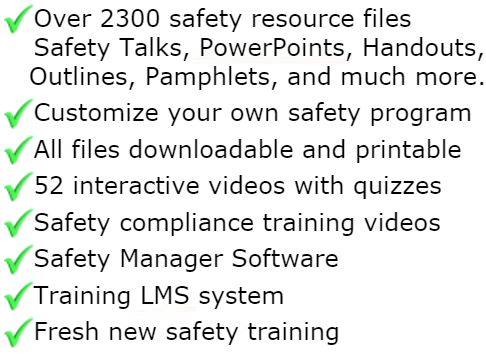
Construction Safety Requirements
Construction safety requires that employers assess the construction site to determine if the walking or working surfaces on which employees are to work have the strength and structural integrity to safely support workers. Employees are not permitted to work on those construction or facility surfaces until it has been determined that the surfaces have the requisite strength and structural integrity to support the workers.
Once employers have determined that the construction site surface is safe for employees to work on, the employer must select one of the options listed for the work operation if a fall hazard is present.
Construction site Contractors must follow the OSHA Hazard Communication Standard requirements including use safe handling and storage of chemicals. Construction Contractors are required to inform -the-lead contractor of all hazardous substances which may be brought on to the construction site property, including providing the most current Material Safety Data Sheet for each substance. All spills and leaks of hazardous chemicals at the construction site must be immediately reported to the on-site safety supervisor.
Before any excavation actually begins at a construction site, OSHA requires construction contractors to determine the estimated location of utility installations — sewer, telephone, fuel, electric, water lines, or any other underground installations — that may be encountered during digging to ensure safe construction operations. Also, before starting the excavation, the construction contractor must contact the utility companies or owners involved and inform them, within established or customary local response times, of the proposed work. The construction contractor must also ask the utility companies or owners to find the exact location of the underground installations. To ensure safe operations at construction sites, iIf underground installations are exposed, OSHA regulations also require that they be removed, protected or properly supported. When all the necessary specific information about the construction job site is assembled, the contractor can safely determine the amount, kind, and cost of the safety equipment needed. A careful inventory of the safety items on hand should be made before deciding what additional safety material must be acquired.
Construction Scaffold Safety
The most common accident involving scaffolds at construction sites is a fall to a lower level. That's quite obvious, since the purpose of erecting scaffolds is to provide a safe place to work when you must work at a height above ground level. It is up to the construction contractor to safely determine the exact scaffold requirements to provide for safety around scaffolds.
All construction site scaffolds must be constructed to safely support a weight four times the maximum intended load. For example, a scaffold normally expected to hold a 200 pound man and his twenty pounds of material should be designed to support 880 pounds without breaking. To be on the safe side, you should never load a scaffold beyond the maximum intended weight. Always inspect the construction site scaffold. Make sure the planks are laid with their edges close together so no tools or materials can slip through and strike someone below. Plank ends must be overlapped at least twelve inches or nailed, so the planks will not move when you walk on them. Construction scaffold planks must not extend more than 18 inches or less than six inches beyond the supports. If the planks extend more than 18 inches, you run the risk of walking on unsupported ends.
Construction Hand & Power Tool Safety
Professionals in the construction industry take pride in their crafts and certainly in the tools they use. any tools that are designed to have guards and handles must have those guards and handles unaltered and they must be in place at all times.
Tying back a guard on a saw doesn't make any sense and anyone removing a guard, handle, or using an unguarded tool will be subject to dismissal from the jobsite. It's just too important to take chances. The power supply for electrical tools must be disconnected when not in use or when changing blades, bits, discs or other routine maintenance tasks.
Loose clothing, rings or other jewelry cannot be worn around operating tools or machines. Keep shirt sleeves buttoned. Industrial leather gloves should be worn when using tools. Before you use any grinding tools, you must be trained and authorized. Using grinders without proper training is asking for trouble.
When grinders are rotating, the operator must assure the operator is in a balanced position and the momentum of the disc will carry the tool away from the operator if it becomes stuck.
Dead-man switches are required on all tools. If you release the power trigger, the tool must shut off. Lock-on devices are prohibited. Make sure all hand and powered hand tools are in serviceable condition before you use them.
Construction Contractor Safety
As a Construction Industry Contractor, it's important for you and all employees on the jobsite to work and act safely. It's a responsibility.
Regardless of your job, your trade or your relationship with the General Contractor, or other contractors working on the job site, there are basic safety rules that must be followed at all times. Each company or contractor has the responsibility to make sure all employees follow safety and health rules and any specific or special rules of the jobsite.
Each contractor should have a written Injury and Illness Prevention Plan for employees that documents the job safety and health requirements and to make sure all employees are trained in these requirements. Employee safety training, regardless of job experience is mandatory. General safe work practices are important, as is specific training for those jobs with potential special hazards, such as crane operation, powder actuated tools, welding, grinding or other specific type jobs. Each employer on the job site is responsible for all training documentation, OSHA recordkeeping and other required documentation. All employers on a job site are responsible for a written and properly implemented Hazard Communications program, which includes Material Safety Data Sheets for each chemical on the worksite.
In addition to appropriate worker compensation and liability coverage for all employees, it's important that adequate first aid supplies and trained persons be available. Emergency telephone numbers for fire, police and paramedics should be maintained by all work site employers.
Construction accounts for more fatal work injuries, than most of any industry sector. Two occupational groups (construction and extraction occupations and transportation and material moving occupations) together account for nearly half of all fatal work injuries.
Construction accounted for 1,239 fatal work injuries, the most of any industry sector in 2006. The total for construction represented an increase of 3 percent over the 2005 total. Fatalities among specialty trade contractors rose 6 percent due primarily to higher numbers of fatal work injuries among building finishing contractors and roofing contractors.
Two occupational groups (construction and extraction occupations and transportation and material moving occupations) together accounted for nearly half of all fatal work injuries.
Construction laborers accounted for the highest number of fatal work injuries among construction and extraction occupations, accounting for 360 fatal work injuries. Fatalities among electricians, roofers, painters, and drywall and ceiling tile installers also rose. Fatalities decreased among carpenters, construction trade helpers, and among plumbers, pipefitters, and steamfitters.
Construction hazards
Construction is one of the largest and most dangerous industries in the United States. Bodily harm as a result of misusing equipment or through plain negligence can range anywhere from cuts and scrapes to loss of sight or limbs and even death. Because of all the hazards a construction worker encounters in a typical day, injuries occur regularly. And of those injuries, eye injuries, in particular, are the most common.
What causes eye injuries
Two main reasons for construction site eye injuries on the job are: not wearing eye protection or wearing the wrong kind of eye protection for the job. Not wearing eye protection is obviously dangerous. What most workers don't realize, however, is that wearing the wrong kind of eye protection can be just as hazardous. In fact, most workers who have suffered eye injuries while wearing protective eyewear realize later that the trauma was inflicted from objects or chemicals going around or under their ill-fitting safety eyewear.
Unfortunately for construction workers, their line of work puts them in contact with just about every eye hazard known to the safety industry: impact, ultraviolet radiation, liquid splash and infrared radiation. Many construction tasks generate flying debris which can seriously injure the eyes. From wood and paint chips to dirt, concrete particles and even nails, a construction worker's eyes are constantly and most often at risk from impact hazards. Injuries from ultraviolet radiation (UV), liquid splash, and infrared radiation (IR) occur also but are notas common.
If you work in outdoor construction sites, UV rays are present in ordinary sunlight and can cause great damage to the eyes. Because construction often takes workers both indoors and out, workers in this industry often don't see this hazard as a serious one. Construction workers also come in contact with highly toxic cleaning chemicals, paints and adhesives. For this reason, liquid/chemical splash hazards are prevalent. Contact from these substances can cause momentary vision loss or even blindness, not to mention burning and discomfort in the eyes.
Last but not least is infrared radiation. The torch welding and cutting that construction workers do produces an invisible hazard that can damage the cornea and retina of the eye. In extreme cases, it causes blindness.
All materials in the members area for this topic index

GET INSTANT ACCESS
to THE MEMBERS LIBRARY
Safety materials created by safety professionals.
Access to the Safety Manager software.
Wide variety of safety videos and courses.
**Brand New** Safety Training Management System
Pre-Made Safety Materials Ready For Use
Created by experienced safety professionals & risk consultants. Saving you time, money, and risk of injuries.
95% of the work already done.
Below are the maximum penalty amounts, with the annual adjustment for inflation, that may be assessed after Jan. 15, 2024. (See OSHA Memo, Jan. 8, 2024).

**New OSHA HEAT 90 DAY**
>>Download Free HERE<<
**New 2024 OSHA 300 Form**
>>Download Free HERE<<
**Brand New**
Free with full membership subscription
Training LMS System
Ask The Safety Consultant
Safety Equipment Deal Finder

“SafetyInfo.com is the first go-to website for safety professionals and companies to use in establishing a solid safety program"
-Mike McKenzie, Certified Safety & Health Manager (CSHM), McSafety Solutions™
Note: You must have a full subscription to the Safety Library in order to use this material. Any use outside of your organization, for resell, or without an active membership is strictly prohibited and may result in prosecution under copyright infringement laws. Please contact us first, if you would be interested in reselling or using our materials for reproduction.
Inside the Members Library
Topic Index
Accident Prevention
Air Quality
Asbestos
Bloodborne Pathogens
Boilers
Chemical Safety
Compressed Gas
Confined Space
Construction
Construction Worksite
Cranes & Slings
Driver / Fleet Safety
Drug Free Workplace
Electrical
Emergency Management
Engineering Safety
Environmental
Equipment
Ergonomics
Fall Protection
Fire Safety & Prevention
First Aid
Flammable Materials
Forklifts
Hazard Communication
Hazardous Materials
Hearing Protection
Heat Stress
Hot Work
Housekeeping
Job Safety Analysis
Laboratory
Ladders
Lead
Lockout-Tagout
Machinery & Equipment
Material Handling
MSDS (SDS)
Medical & First Aid
Occupational Health
Office Safety
Off the Job Safety
Personal Protection
Process Safety
Record Keeping
Respiratory Protection
Silica Safety
Rules & Policies
Signs & Labels
Slips, Trips & Fall
Training
Terrorism Programs
Tool Safety
Vehicle & Driver
Violence Programs
Welding & Hot Work
Training Videos
Library Index
Training Materials
Videos/Courses
Talks
Articles
PowerPoint
Handouts
Training Overheads
Quizzes
Supervisor Briefs
Management Briefs
Safety Sessions
2 Minute OSHA Safety Talks
Pamphlets
First Aid Training
Supervisor Training
Hazardous Materials
Bomb Threat
Crossword Puzzles
Biological Agents
Forms & Documents
Forms
Checklists
Audit Guides
Inspections Guides
Signs & Labels
Environmental Audit Guides
Recordkeeping - OSHA 300
Sign & Label Maker
Safety Management Resources
Safety Manuals/Written Programs
Ergonomic Programs
Emergency Plans
Process Safety Management
Construction Safety
Occupational Health
Environmental
Topic Sheets
DOT Fleet-Driver
Hazardous Materials
Chemical Safety
Drug Free Workplace
Terrorism Programs
Development Guides
Safety Manager Software
Safety References & Graphics
Technical Safety Information
Posters
Topic & Fact Sheets
Development Information
Job Specific Safety Rules
Terrorism
Calculators
Safety Comic Strips
New Safety Training System
Schedule and train your employees with our materials. Add unlimited amount of employees. Record all progress and issue certificates. For group and individual training sessions.

